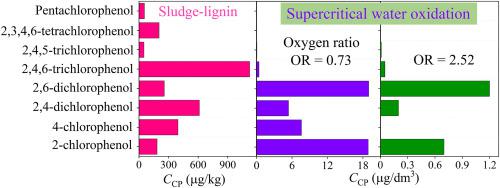Chemosphere ( IF 8.8 ) Pub Date : 2021-06-18 , DOI: 10.1016/j.chemosphere.2021.131239 Oxana N Fedyaeva 1 , Sergey V Morozov 2 , Anatoly A Vostrikov 1

|
The article presents the research results of the oxidation of watered toxic waste from the pulp and paper industry (sludge-lignin, the empirical formula of organic matter CH1.51N0.05S0.03Cl0.01O0.54) in supercritical water-oxygen (SCW/O2) fluid. The experiments were carried out using a flow tube reactor at a pressure of 25 MPa, temperature gradient along its vertical axis (from top to bottom: 390–600 °C), sludge-lignin flow rate of 9.5–14.5 g/min, oxygen ratio OR = 0.73–2.52, using NaOH (1.6 wt%) as a catalyst. Employing gas chromatography – mass spectrometry, polychlorophenols were identified in the composition of sludge-lignin, in which 2,4,6-trichlorophenol was the main component. The total yield of extracted phenols and chlorophenols per sludge-lignin organic matter was 20.82 and 2.88 μg/g, respectively. It is revealed that the conversion rate of sludge-lignin in SCW/O2 fluid is limited by heterogeneous oxidation of the carbonized residue, and is determined by the O2 content in the reaction mixture. At OR ≥ 1.16, only CO2, CO, N2, and N2O were detected in the volatile oxidation products. An increase in OR from 0.73 to 2.52 leads to a decrease in the total content of phenols (from 45540.1 to 129.3 μg/dm3) and chlorophenols (from 51.4 to 2.2 μg/dm3) in the water collected at the reactor outlet. It is shown that 2,6-dichlorophenol and 2-chlorophenol are the most resistant to oxidation. From the analysis of the initial sludge-lignin and mineral residues, it follows that the bulk of the chlorine contained in its organic matter is converted into NaCl in the course of oxidation.
中文翻译:

制浆造纸厂氯化废物的超临界水氧化
本文介绍了制浆造纸工业含水有毒废物(污泥-木质素,有机物的经验公式 CH 1.51 N 0.05 S 0.03 Cl 0.01 O 0.54)在超临界水-氧(SCW/O 2) 体液。实验采用流管式反应器,压力为 25 MPa,沿其纵轴的温度梯度(从上到下:390–600 °C),污泥-木质素流速为 9.5–14.5 g/min,氧气比率 OR = 0.73–2.52,使用 NaOH (1.6 wt%) 作为催化剂。采用气相色谱-质谱联用技术,在污泥-木质素组成中鉴定出多氯酚,其中以2,4,6-三氯苯酚为主要成分。每单位污泥-木质素有机物的提取酚和氯酚的总产量分别为20.82和2.88 μg/g。结果表明,SCW/O 2流体中污泥-木质素的转化率受炭化残渣异相氧化的限制,由O 2反应混合物中的含量。在OR ≥ 1.16 时,挥发性氧化产物中仅检测到CO 2、CO、N 2和N 2 O。OR 从 0.73 增加到 2.52 导致在反应器出口收集的水中酚类(从 45540.1 到 129.3 μg/dm 3)和氯酚(从 51.4 到 2.2 μg/dm 3)的总含量降低。结果表明,2,6-二氯苯酚和2-氯苯酚最耐氧化。从对初始污泥-木质素和矿物残留物的分析可知,有机物中所含的大部分氯在氧化过程中转化为 NaCl。



























 京公网安备 11010802027423号
京公网安备 11010802027423号